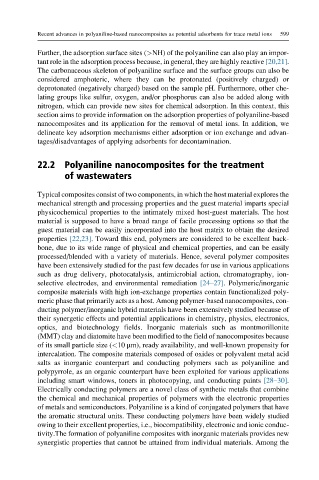Page 649 - Polymer-based Nanocomposites for Energy and Environmental Applications
P. 649
Recent advances in polyaniline-based nanocomposites as potential adsorbents for trace metal ions 599
Further, the adsorption surface sites (>NH) of the polyaniline can also play an impor-
tant role in the adsorption process because, in general, they are highly reactive [20,21].
The carbonaceous skeleton of polyaniline surface and the surface groups can also be
considered amphoteric, where they can be protonated (positively charged) or
deprotonated (negatively charged) based on the sample pH. Furthermore, other che-
lating groups like sulfur, oxygen, and/or phosphorus can also be added along with
nitrogen, which can provide new sites for chemical adsorption. In this context, this
section aims to provide information on the adsorption properties of polyaniline-based
nanocomposites and its application for the removal of metal ions. In addition, we
delineate key adsorption mechanisms either adsorption or ion exchange and advan-
tages/disadvantages of applying adsorbents for decontamination.
22.2 Polyaniline nanocomposites for the treatment
of wastewaters
Typical composites consist of two components, in which the host material explores the
mechanical strength and processing properties and the guest material imparts special
physicochemical properties to the intimately mixed host-guest materials. The host
material is supposed to have a broad range of facile processing options so that the
guest material can be easily incorporated into the host matrix to obtain the desired
properties [22,23]. Toward this end, polymers are considered to be excellent back-
bone, due to its wide range of physical and chemical properties, and can be easily
processed/blended with a variety of materials. Hence, several polymer composites
have been extensively studied for the past few decades for use in various applications
such as drug delivery, photocatalysis, antimicrobial action, chromatography, ion-
selective electrodes, and environmental remediation [24–27]. Polymeric/inorganic
composite materials with high ion-exchange properties contain functionalized poly-
meric phase that primarily acts as a host. Among polymer-based nanocomposites, con-
ducting polymer/inorganic hybrid materials have been extensively studied because of
their synergetic effects and potential applications in chemistry, physics, electronics,
optics, and biotechnology fields. Inorganic materials such as montmorillonite
(MMT) clay and diatomite have been modified to the field of nanocomposites because
of its small particle size (<10 μm), ready availability, and well-known propensity for
intercalation. The composite materials composed of oxides or polyvalent metal acid
salts as inorganic counterpart and conducting polymers such as polyaniline and
polypyrrole, as an organic counterpart have been exploited for various applications
including smart windows, toners in photocopying, and conducting paints [28–30].
Electrically conducting polymers are a novel class of synthetic metals that combine
the chemical and mechanical properties of polymers with the electronic properties
of metals and semiconductors. Polyaniline is a kind of conjugated polymers that have
the aromatic structural units. These conducting polymers have been widely studied
owing to their excellent properties, i.e., biocompatibility, electronic and ionic conduc-
tivity.The formation of polyaniline composites with inorganic materials provides new
synergistic properties that cannot be attained from individual materials. Among the

